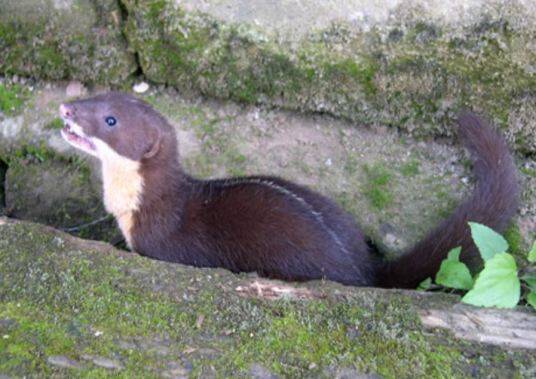Mustela strigidorsa
IUCN
LCBasic Information
Scientific classification
- name:Mustela strigidorsa
- Scientific Name:Mustela strigidorsa,Stripe-backed Weasel、Back-striped Weasel,Weasel
- Outline:Carnivora
- Family:mustelida mustelae genus
Vital signs
- length:30-36cm
- Weight:1-2kg
- lifetime:No verification information
Feature
A distinctive cream-colored stripe running from the middle of the nape to the front third of the tail
Distribution and Habitat
The spotted weasel is found throughout East Asia, from the eastern Himalayas to southern China and northern Southeast Asia. It is found in northern India, central Myanmar, southern China, northern Thailand, and central and northern Laos and Vietnam. The southern limit of the species remains unclear.
In China, it is only found in Menglun, Yuanyang (Xinjie), Wenshan, Mengla, Yunnan.
Habitats include dense hilly jungle and moderate forests throughout the Pacific distribution range. It can be found in overgrown forests throughout its range and also lives in evergreen forests in Thailand and Vietnam. It is a montane species. Prefers relatively high altitudes. Altitudes range from 90 meters in northern Myanmar to 2500 meters in India. It inhabits river valleys at altitudes of 90-2500 meters in China. It mainly inhabits evergreen forests in hilly and mountainous areas, including dense scrub, secondary forests, grasslands and farmlands.
Appearance
The striped weasel has typical characteristics of weasels. It weighs 1-2 kg and is 30-36 cm long. The tail of this species is very long, 18-20 cm long. The body shape is similar to that of the yellow weasel. The body is short-haired. The nose pad is flesh-red. There are lateral hairs in front of the eyes, cheeks and corners of the mouth. The tail is longer than half of the body length, and the tail hair is long and slightly fluffy. It is a walking animal. The soles of the feet are bare, and the pads of the palms and toes are well developed. Both the front and hind feet have 5 toes, and the claws at the end of the toes are short and slightly weak. Hair color: In summer, the body hair is reddish brown and shiny. The lower half of the hair and the undercoat are light brown, and there are white or light-colored needle hairs scattered in the hair. The hair color of the snout, forehead and neck is slightly lighter, brown. There is a narrow silver-white stripe in the center of the back from t
Details
Stripe-backed Weasel (scientific name: Mustela strigidorsa) is also known as Stripe-backed Weasel or Back-striped Weasel in foreign languages. Its size and body color are similar to those of the yellow-bellied weasel, and it has no subspecies.

Stripe-backed Weasel may be a diurnal species, mostly acting alone. They mark their territories with scent, which also serves as an intraspecific communication mechanism to maintain territoriality. They probably have different sexual ranges, with males having significantly larger territories than females, and territories of conspecifics of the opposite sex often overlap.
Little is known about the dietary habits of the weasel. One prey species is the bandicoot. Weasels attack it by biting the nose. Weasels forage around dead wood, checking cracks and holes for insects, grubs, and worms inside dead wood. Weasels have also been documented hunting and capturing other rodents near streams.
Little is known about the reproductive behavior of the weasel. It is not known whether this species has delayed implantation, a reproductive trait that is not uncommon in mustelids. Most other species of the genus Mustela breed seasonally, usually for 3-4 months. Delayed implantation is required, and it may take up to 10 months for a fertilized embryo to implant in the species' uterus. Environmental conditions such as temperature and day length determine when implantation occurs. Mustelids living in more seasonal climates are more likely to have delayed implantation. After implantation, gestation usually lasts 30-65 days. Females give birth to one litter per season. The pups are altricial, born small and blind, and reach sexual maturity between 8 months and 2 years after birth.
The spotted mustelid has no significant conservation needs. The rate of habitat decline is fairly low, as it is found in degraded and fragmented forests, and has a high proportion of its numbers in mountainous and montane areas with relatively low rates of forest conversion. In addition, it is not targeted for collection markets, except for the fur market in China. The species has been included in many planned protected areas throughout its range. Many of these reserves have protection measures to prevent hunting and small-scale habitat loss, and the main conservation concern for the species in the long term may be the risk of inadequate actual security of declared protected areas.
Listed in the IUCN Red List of Threatened Species in 2015 ver 3.1 - Least Concern (LC).
Protect wild animals and eliminate game.
Maintaining ecological balance is everyone's responsibility!








